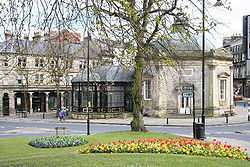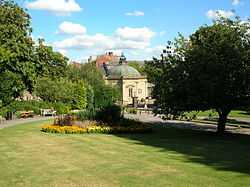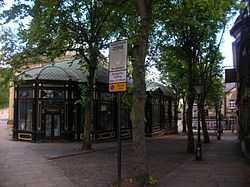Royal Pump Room, Harrogate


The Royal Pump Room is a museum and former spa water pump, located in the town of Harrogate, North Yorkshire, England.
Background
Debate continues to this day over whom and when the waters of Harrogate were discovered. Generally believed to be Sir William Slingsby who discovered Tewit Well, the dates varies between 1576 and 1620. Born in Scriven in 1562, he did not return from the continent until 1594, so the most likely dates seem to be from 1596 onwards. John's Well or the Sweet Spaw was discovered in 1631 by Dr. Michael Stanhope of York.[1]
The Royal Pump Room sits atop the Old Sulphur Wells in Low Harrogate, which as the highest concentrate of sulphur water wells in all of Europe did not need to be "discovered" due to their smell. One of the earliest set of wells in commercial operation in Harrogate, the others were in Bilton Park and Harlow Car.
Health spa
The number of wells and springs for medicinal use was small until the mid-Victorian age. In 1864 there were 16 distinct wells, but by 1886 there were 30, with most of the sulphur water pumped to supply the Victoria Baths. Only two springs were used for drinking: the Hospital Strong Sulphur Well, and the Magnesia Spring, over which the Improvement Commissioners later built a pump room in 1858.[2]
New building: 1842
The Royal Pump Room sits over the Old Sulphur Well, with the current Grade II* building designed by Isaac Thomas Shutt. [3] It was finished in 1842 and was the first project of the newly formed Improvement Commissioners, whose aim was to provide a suitable building to house the sulphur well. The previous cover of the well was removed to Tewit Well, where it still stands today.
As a result, the popularity of sampling the waters and hence visiting Harrogate soared: 1842 it had 3778 drinkers; in 1867 it was 11,626; in 1925 it was 259,000.[4] Promoted as having healing qualities to cure anything from gout to lumbago, visitors included Tsar Nicholas II of Russia, and the novelist Charles Dickens, who described Harrogate as: "The queerest place with the strangest people leading the oddest lives!"[5]
Present day: museum

The pump room was purposefully stopped at the start of World War II, and was subsequently decommissioned after the cessation of hostilities. Renovated as a museum and opened in 1953, today owned and operated by Harrogate Borough Council as a museum. It is no longer possible to sample the waters inside, or from a pump outside due to a February 2012 EU directive which found the chemical composition of the water to be unacceptable for human consumption.[2]
The museum tells the story of Harrogate as a spa, with the programme of temporary exhibitions drawn from a collection of 20,000 items in the council-owned reserve collection. Mostly given by generous benefactors from the 1850s onwards, they range from ancient Egyptian artifacts to items from the 1960s. There is also a supervised children activity area, that includes colouring sheets, trails and quizzes.[2]
References
- ↑ "Discovery of the Harrogate Waters". North Yorkshire Council. Retrieved 9 September 2011.
- ↑ 2.0 2.1 2.2 "Royal Pump Room". Harrogate Borough Council. Retrieved 2012-01-06.
- ↑ "Name: ROYAL PUMP ROOM MUSEUM List entry Number: 1149478". English Heritage. Retrieved 1 September 2014.
- ↑ "Royal Pump Rooms". North Yorkshire Council. Retrieved 9 September 2011.
- ↑ "Harrogate". which.co.uk. Retrieved 2012-01-06.
External links
- Royal Pump Room at Harrogate Borough Council
- Aeden Plus: The Royal Pump Room Archive images of Pump Room